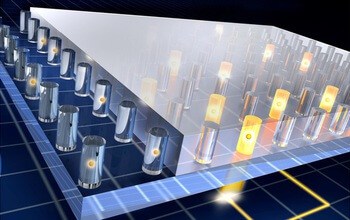The National Science Foundation (NSF) and Semiconductor Research Corporation (SRC) have jointly awarded $21.6 million for nine new projects to find revolutionary solutions that will enable more energy-efficient computing, from brain-inspired computer architectures to hybrid digital-analog designs.
Researchers aim to create a new type of computer that can proactively interpret and learn from data, solve unfamiliar problems using what it has learned, and operate with the energy efficiency of the human brain, as detailed by the White House when it announced the Nanotechnology-Inspired Grand Challenge for Future Computing.
“Only disruptive breakthroughs can enable computers to perform as the human brain does, in terms of problem-solving capability and lower power, which, for the human brain, is less than a light bulb’s worth of consumption,” said Dimitris Pavlidis, NSF’s Directorate for Engineering program director for the Energy-Efficient Computing: from Devices to Architectures (E2CDA) initiative.
U.S. computing capabilities rely on the continuous research and development of new computing systems with rapidly increasing performance. Yet, improvements in computing performance are severely limited by the amount of energy needed to manipulate, store and transport data.
According to Pavlidis, the newly awarded, three-year projects consider simultaneously novel approaches — including developing nanoscale devices and materials and integrating them into three-dimensional systems — while inventing new computer architectures to process, store and communicate data.
Investing in the human-technology frontier
The new effort aligns with one of NSF’s big ideas for future investment: to advance the human-technology frontier.
“This research aims to spark the interdisciplinary science and engineering needed to shape the future of computing,” said Sankar Basu, program director in NSF’s Directorate for Computer and Information Science and Engineering. “This effort aims to create the fundamental base required to later tackle the bigger problems.”
The new endeavor draws on the strengths of partners in industry as well as academia.
“The E2CDA program is a culmination of more than five years of working with our NSF partners to define a major new academic research initiative,” said Jonathan Candelaria, SRC program director. “This initiative has the potential to create a truly disruptive breakthrough by identifying the most probable path towards creating a new computing paradigm — one that is orders of magnitude more energy efficient, and just as importantly incorporates cognitive self-learning capabilities alongside programmable arithmetic computation.”
The effort builds upon a history of NSF investments in fundamental engineering, computer science and materials research. For instance, significant investments by NSF and the Air Force Office of Scientific Research beginning in 2014 allowed researchers to pursue transformative research in the area of 2-D atomic-layer research and engineering (2-DARE), leading to advances in electronics, photonics, sensors and other applications.
In addition to the Nanotechnology-Inspired Grand Challenge for Future Computing, the jointly supported research effort aligns with the National Strategic Computing Initiative and other interagency initiatives and priorities.
The nine E2CDA projects are:
- 2D Electrostrictive FETs for Ultra-Low Power Circuits and Architectures, Saptarshi Das, Pennsylvania State University
- A Fast 70 mV Transistor Technology for Ultra-Low-Energy Computing, Benton Calhoun, University of Virginia; Mykhailo Povolotskyi, Purdue University; and Mark Rodwell, University of California, Santa Barbara
- Electronic-Photonic Integration Using the Transistor Laser for Energy-Efficient Computing, John Dallesasse, University of Illinois at Urbana-Champaign; and Yanjing Li, University of Chicago
- Energy Efficient Computing with Chip-Based Photonics, Yeshaiahu Fainman, University of California, San Diego; Alexander Gaeta, Columbia University; Benjamin Lev, Stanford University; and Marin Soljacic, Massachusetts Institute of Technology
- Energy Efficient Learning Machines, Subhasish Mitra, Stanford University; and Sayeef Salahuddin, University of California, Berkeley
- Excitonic Devices, Leonid Butov, University of California, San Diego
- EXtremely Energy Efficient Collective ELectronics, Suman Datta, University of Notre Dame
- Memory, Logic and Logic in Memory Using Three Terminal Magnetic Tunnel Junctions, Marc Baldo, Massachusetts Institute of Technology
- Self-Adaptive Reservoir Computing with Spiking Neurons: Learning Algorithms and Processor Architectures, Peng Li, Texas A&M Engineering Experiment Station


